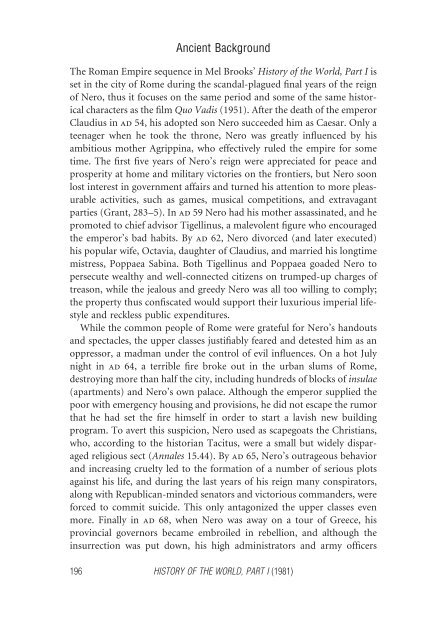Big Screen Rome - Amazon Web Services
Big Screen Rome - Amazon Web Services
Big Screen Rome - Amazon Web Services
You also want an ePaper? Increase the reach of your titles
YUMPU automatically turns print PDFs into web optimized ePapers that Google loves.
Ancient Background<br />
The Roman Empire sequence in Mel Brooks’ History of the World, Part I is<br />
set in the city of <strong>Rome</strong> during the scandal-plagued final years of the reign<br />
of Nero, thus it focuses on the same period and some of the same historical<br />
characters as the film Quo Vadis (1951). After the death of the emperor<br />
Claudius in ad 54, his adopted son Nero succeeded him as Caesar. Only a<br />
teenager when he took the throne, Nero was greatly influenced by his<br />
ambitious mother Agrippina, who effectively ruled the empire for some<br />
time. The first five years of Nero’s reign were appreciated for peace and<br />
prosperity at home and military victories on the frontiers, but Nero soon<br />
lost interest in government affairs and turned his attention to more pleasurable<br />
activities, such as games, musical competitions, and extravagant<br />
parties (Grant, 283–5). In ad 59 Nero had his mother assassinated, and he<br />
promoted to chief advisor Tigellinus, a malevolent figure who encouraged<br />
the emperor’s bad habits. By ad 62, Nero divorced (and later executed)<br />
his popular wife, Octavia, daughter of Claudius, and married his longtime<br />
mistress, Poppaea Sabina. Both Tigellinus and Poppaea goaded Nero to<br />
persecute wealthy and well-connected citizens on trumped-up charges of<br />
treason, while the jealous and greedy Nero was all too willing to comply;<br />
the property thus confiscated would support their luxurious imperial lifestyle<br />
and reckless public expenditures.<br />
While the common people of <strong>Rome</strong> were grateful for Nero’s handouts<br />
and spectacles, the upper classes justifiably feared and detested him as an<br />
oppressor, a madman under the control of evil influences. On a hot July<br />
night in ad 64, a terrible fire broke out in the urban slums of <strong>Rome</strong>,<br />
destroying more than half the city, including hundreds of blocks of insulae<br />
(apartments) and Nero’s own palace. Although the emperor supplied the<br />
poor with emergency housing and provisions, he did not escape the rumor<br />
that he had set the fire himself in order to start a lavish new building<br />
program. To avert this suspicion, Nero used as scapegoats the Christians,<br />
who, according to the historian Tacitus, were a small but widely disparaged<br />
religious sect (Annales 15.44). By ad 65, Nero’s outrageous behavior<br />
and increasing cruelty led to the formation of a number of serious plots<br />
against his life, and during the last years of his reign many conspirators,<br />
along with Republican-minded senators and victorious commanders, were<br />
forced to commit suicide. This only antagonized the upper classes even<br />
more. Finally in ad 68, when Nero was away on a tour of Greece, his<br />
provincial governors became embroiled in rebellion, and although the<br />
insurrection was put down, his high administrators and army officers<br />
196 HISTORY OF THE WORLD, PART I (1981)



